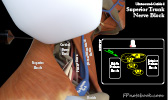II. Indications
- Shoulder Anesthesia
- Alternative to the Interscalene Nerve Block, with less transient phrenic nerve paralysis risk
III. Background
- Superior brachial trunk forms from joining of the C5 and C6 nerve roots
- Superior Trunk Block targets this trunk as it gives off the suprascapular nerve branch
- Suprascapular nerve innervates the skin over the clavicle and the cape of the Shoulder
IV. Complications
- See Regional Anesthesia
- LAST Reaction
- Phrenic Nerve paralysis (transient)
- Less common than with Interscalene Nerve Block
V. Technique
- Images
- Equipment
- Needle 22 gauge, 5 to 10 cm blunt tipped or short bevel Nerve Block needle
- Anesthetic (Ropivacaine) 10 to 15 ml
-
Ultrasound (high Frequency linear probe)
- Similar approach as for Interscalene Nerve Block
- Ultrasound probe in Transverse Plane along the lateral neck
- Start at the supraclavicular fossa
- Subclavian artery medial
- Brachial Plexus lateral
- Slide probe upward where the superior trunk divides proximally into its C5, C6 roots
- Injection
- Needle inserted in-plane lateral to medial
- Direct needle toward (but not contacting) C5 and C6 and inject 10 ml in this region
- Withdraw and redirect needle toward supraclavicular nerve and inject another 5 ml in this region
- Supraclavicular nerve runs over the surface of the middle scalene Muscle
- Injecting over the middle scalene surface will anesthetize the supraclavicular nerve
VI. Resources
- Superior Trunk Block (Chin, YouTube)

